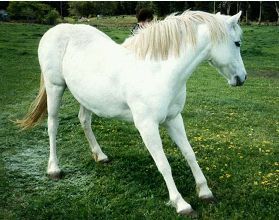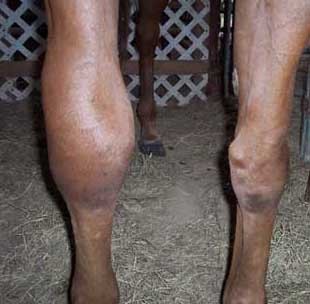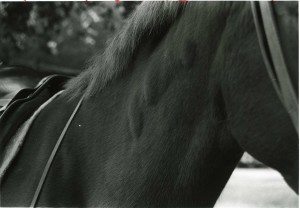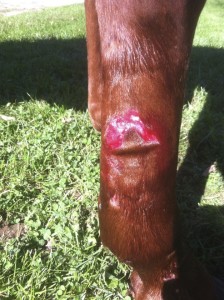Emergency Medicine:
What to do before the veterinarian arrives
An emergency can be very worrisome, but there are many things you can do while you’re waiting for your veterinarian to arrive.
- Take rectal temperature. Normal is between 99-101.5 degrees Fahrenheit.
- Note their appetite – did the horse finish their last meal?
- Pay attention to poop– when was the last pile produced?
- Note when the horse was last normal and when the abnormality was first noticed.
- Look at the water buckets – a normal 1200 lb horse should drink two 5-gallon buckets in 24 hours.
Top 10 emergencies: What to look for
 Laminitis:
Laminitis:
Horses with an acute episode of laminitis (founder) often appear as if they are “walking on eggshells” with their front feet placed far out in front of themselves. These horses are painful when walking or turning, especially on hard surfaces. They are often unwilling to pick up one front foot because it is too painful to stand with their weight on the other foot. Horses that have been exposed to black walnut shavings or have grain overload, colitis, a retained placenta, pneumonia or many other causes are at risk for developing laminitis.A related but different type of laminitis is caused by Equine Metabolic Syndrome. These horses may be sore in their front feet off and on and may develop growth rings on their feet that are wider at the heel than at the toe. These horses often have cresty necks and are “easy keepers”. Diagnosing and treating the underlying condition and careful management is the key to keeping these horses comfortable in their feet.
Colic:
Abdominal pain in horses often comes from the digestive tract and can range in severity from decreased interest in food to severe pain. A horse with colic may have decreased manure production and may be restless, looking at their flanks, pawing, or rolling violently. Colic can be caused by any number of factors from poor horse management to individual predisposing factors for each horse. The digestive system of the horse is a long tube that winds around and changes size from small to large and back to small again over and over again. Therefore, there are many places for horses to have problems in their digestive system. Common causes of colic include dehydration, stomach ulcers, parasites, ingestion of abnormal material (such as sand, grass clippings, large amounts of grain, etc.), infection, management changes or other stressors, poor dental conditions and others.
Wounds:
A small wound that does not completely go through the skin can often be managed with good first-aid principles. However, any wound that is through the skin should be examined by a veterinarian to see if stitches are required. Any wounds near a joint should also be examined, as these require immediate attention, for a delay in appropriate treatment can add months to the recovery process.
Any wound should be considered a puncture wound until it is evaluated more thoroughly. If any wound has uncontrolled bleeding, call your veterinarian immediately and apply pressure over a clean bandage.
Swollen eye:
A rule of thumb is that an abnormal eye should never wait. Any eye that has swollen eyelids, discharge, cloudiness or any horse squinting an eye should be examined by a veterinarian as soon as possible.
Acute and severe lameness:
When a horse is so painful that he is unwilling to bear weight fully on his limb, he needs immediate care. The cause of this kind of pain can vary widely, from an abscess to a broken bone and should not wait. Horses that will not bear weight on one leg are at risk for developing laminitis in the other foot.
Swollen limbs:

Any swollen limb deserves attention. If it is affiliated with a fever and pain when the leg is touched, the horse may have a cellulitis which often requires intravenous antibiotics to treat.
Choke (Esophageal Obstruction):
Choke in horses usually causes food material to come out of the nose. Affected horses will extend their neck, trying to swallow the food that is stuck in their esophagus and may appear colicky and agitated. Horses that are choking often inhale saliva and food material and are at risk for developing pneumonia once the choke has resolved.
Tying-up (Exertional Rhabdomyolysis):
Signs that a horse is tying up include muscle stiffness, sweating and a reluctance to move. You may see very firm gluteal muscles and dark or coffee-colored urine. There are many different causes of tying up, from polysaccharide storage myopathy (PSSM) to abnormal muscle calcium regulation, but they all result in break-down of muscle, releasing dangerously high levels of creatine kinase into the bloodstream which can be very damaging to the kidneys. The immediate treatment for these horses includes intravenous fluids and anti-anxiety medication.
Fever:
Any rectal temperature above 101.5 degrees Fahrenheit is abnormal in a horse and represents a fever or overheating. A fever is the body’s normal response to an infection and is an important marker that there is a problem with your horse.
Allergic Reaction:

Horses may act abnormally, be agitated, show signs of colic and may or may not scratch themselves if they are having an allergic reaction.
This can be caused by reactions to medications, allergens, bee-stings as well as other causes.
Look for facial swelling or noisy breathing, as these are signs that the throat is closing and soon the horse will be unable to breathe.
Normal physical parameters:

As always, call your veterinarian if you think you might have an emergency situation – we are happy to help.















